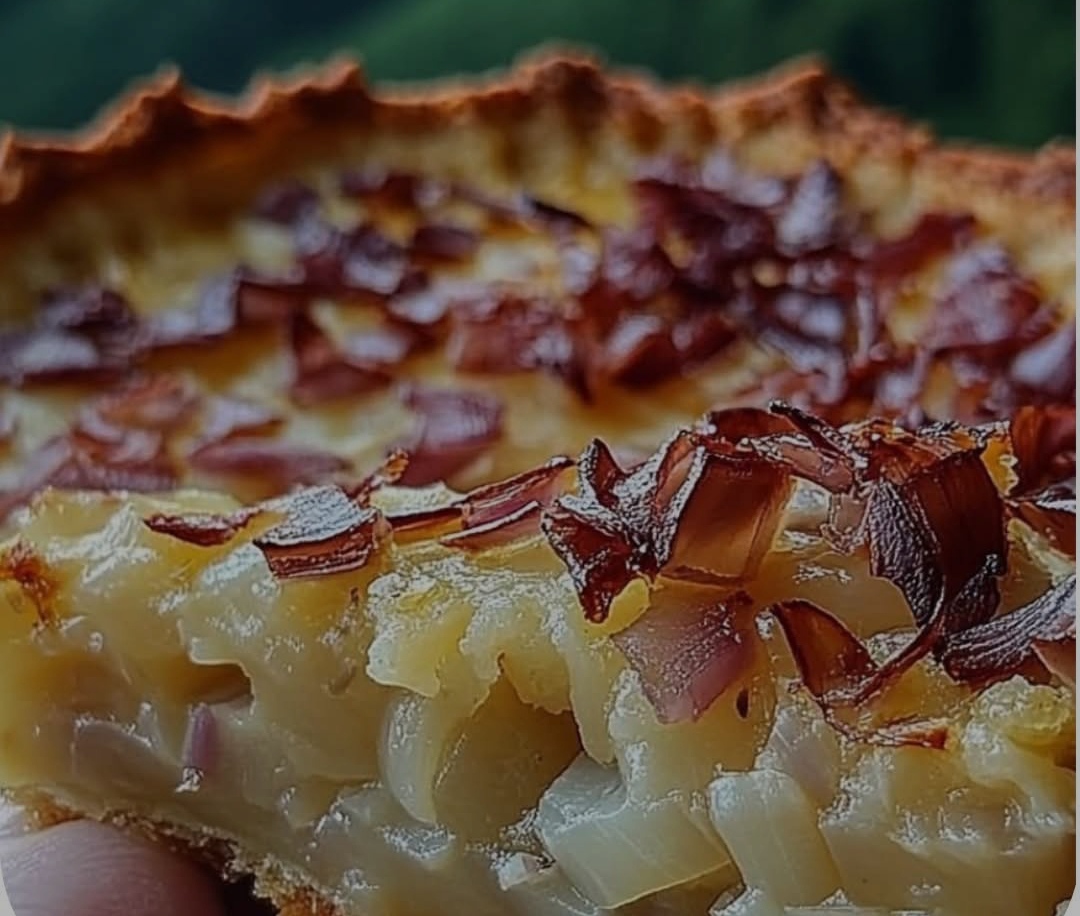Sure! Here’s a full, rich exploration of German Onion Pie (Zwiebelkuchen)—a hearty, old-world favorite—with everything from history to nutrition and more.
German Onion Pie (Zwiebelkuchen): A Hearty Slice of Tradition
Introduction
German Onion Pie, or Zwiebelkuchen, is a beloved savory dish that hails from the regions of Southern Germany, especially Swabia and the Rhineland. Traditionally served during the fall wine harvest, this dish brings together humble ingredients like onions, bacon, and a custardy cream base into something extraordinary. Its name might not scream decadence, but the rich, savory flavor profile certainly will. It’s often served with a glass of Federweißer (young white wine) in German wine country—rustic comfort food at its finest.
History
Zwiebelkuchen has been a staple in German homes for centuries. Its origins trace back to medieval times when onions were a pantry staple and pork products were readily available. As wine culture flourished, so did the tradition of serving this pie during harvest celebrations. It’s essentially Germany’s answer to French quiche or Italian torta, grounded in local ingredients and traditions. Farmers’ wives would bake it in wood-fired ovens and serve it alongside new wine as a celebration of bounty and community.
Ingredients
For the Crust:
- 1 1/4 cups all-purpose flour
- 1/2 teaspoon salt
- 8 tablespoons unsalted butter, chilled and cubed
- 3 to 4 tablespoons ice water
OR use a store-bought pie crust for convenience.
For the Filling:
- 4 cups yellow onions, thinly sliced (about 3 large onions)
- 6 slices of bacon, chopped
- 1 tablespoon unsalted butter
- 1 teaspoon caraway seeds (optional, traditional)
- 1 cup sour cream
- 2 large eggs
- 1/4 teaspoon ground nutmeg
- Salt and pepper to taste
- 1 tablespoon all-purpose flour (for thickening)
- Chopped chives or green onions for garnish (optional)
Instructions
1. Prepare the Pie Crust
- Combine flour and salt in a bowl.
- Cut in cold butter until the mixture resembles coarse crumbs.
- Add ice water gradually and mix until a dough forms.
- Wrap and chill for 30 minutes, then roll out and place in a 9-inch pie dish.
- Prick the base with a fork and blind-bake at 375°F (190°C) for 10 minutes.
2. Cook the Onions and Bacon
- In a large skillet over medium heat, cook chopped bacon until crispy.
- Remove bacon and drain on a paper towel.
- Add butter to the skillet with bacon fat, then sauté onions for 20–25 minutes until golden and soft.
- Stir in caraway seeds if using.
3. Make the Custard
- In a bowl, whisk together sour cream, eggs, flour, nutmeg, salt, and pepper.
4. Assemble the Pie
- Spread onions and bacon evenly over the pre-baked crust.
- Pour custard mixture on top.
- Bake at 375°F (190°C) for 35–40 minutes until set and lightly browned.
5. Cool and Serve
- Let it rest 10–15 minutes before slicing.
- Garnish with chives if desired.
Serving Suggestions
Serve warm or at room temperature. It pairs wonderfully with:
- Green salad with mustard vinaigrette
- Pickled vegetables
- Crisp white wines like Riesling or Gewürztraminer
- German beer or cider
Nutritional Information (Per Slice – Approximate)
- Calories: 380
- Fat: 28g
- Carbohydrates: 22g
- Protein: 11g
- Fiber: 2g
- Sodium: 620mg
Note: Values vary depending on crust and ingredient choices.
Benefits
- Comforting and Nourishing: Rich in protein and flavor—perfect for colder seasons.
- Great for Meal Prep: Reheats beautifully and makes excellent leftovers.
- Versatile: Can be made vegetarian by omitting bacon and adding mushrooms or leeks.
- Cultural Connection: Brings traditional German culinary heritage to your table.
Formation: A Rustic Culinary Art
This dish is a perfect example of how everyday ingredients—onions, bacon, cream, eggs—can be transformed into something deeply satisfying. The contrast of the flaky crust, velvety custard, and sweet-savory onion blend is a culinary work of art that doesn’t require high technique, just patience and care.
Who Loves German Onion Pie?
- Home cooks who love nostalgic European comfort food.
- Food historians fascinated by regional specialties.
- Wine lovers pairing savory pie with autumn vintages.
- Brunch enthusiasts wanting a hearty, savory option.
- German-Americans longing for a taste of home.
Conclusion
German Onion Pie is more than just a savory bake—it’s a celebration of tradition, a story told through layers of flavor. Whether you’re discovering it for the first time or reliving fond memories of a family kitchen, Zwiebelkuchen offers nourishment for both body and soul. Easy to make and deeply satisfying, it deserves a place on your fall menu—or anytime you crave the coziness of Old-World cuisine.
Would you like a printable or shareable version of this recipe, or maybe a vegetarian variation?
